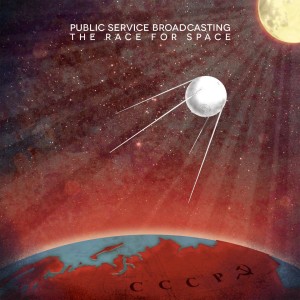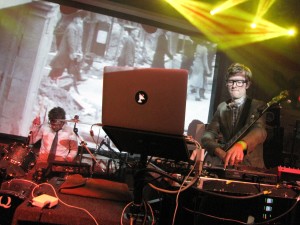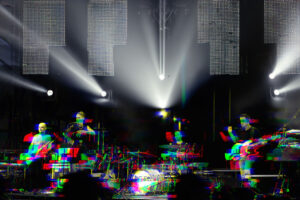On 12 September 1962, John F. Kennedy famously said during a speech:
“We choose to go to the moon. We choose to go to the moon in this decade and do the other things, not because they are easy, but because they are hard…” Side One (and the title track) of Public Service Broadcasting’s new album The Race for Space opens with this speech set to a lovely choral arrangement reminiscent of an Eric Whitacre piece. Kennedy’s speech ends with his retelling of George Mallory’s response to the question of why he would climb Everest: ‘Because it is there’. From a largely documentary framework, this is the essence of the album.
To be sure, The Race for Space is a concept album, but one that’s unlike anything you’ve ever heard before. From its conceptual development to composition, arrangement, orchestration and production, this album represents possibly many thousands of hours or mental and physical labour, and is one of the most aurally connective and immersive historical documentaries ever captured on vinyl, no less by a rock band led by the duo of J. Willgoose and Wrigglesworth.
As you can likely guess from the title, this album dives head long into the history of the race for space between the USSR and America. Typical of Public Service Broadcasting’s style, these tracks feature audio samples from historical events set to multiple musical styles to tell stories that engage the senses and spark the mind. Their new effort chronicles the space programme from the launch of Sputnik to the success of Apollo 17, and in writing this review I found it quite impossible not to address each track as each contributes something essential to the entire experience — some of which were my own experiences.
Amongst my first memories of our forays into space were the media reports and nightly news broadcasts that planted a deep seeded fascination and obsession with space travel in my young mind. It was also this obsession that helped me conquer my own fear of flight. It only stood to reason: if astronauts we’re brave enough to fly to the moon, I could overcome my fears as well. The race for space was all around us, and even at a young age, we sensed there a real excitement that we were going to achieve something thrilling and momentous.
From a global perspective, the world had just emerged from two world wars, but was still in the midst of ongoing conflicts, social upheavals and change. It was an era of rapid scientific and technological development, and with that the hope of a positive future now that the vastness of space was finally within our grasp. The world’s powers diverted national resources to this collective effort. The race for space was on, and yes, we were promised jetpacks.
From the first sounds of The Race for Space, I found myself not simply revisiting this history, but reliving it mentally and emotionally through an artistic expression that deftly melds historical audio clips from various events into an often anticipatory and heart pounding musical experience. It’s an album perhaps best experienced with your eyes closed and the volume way up.
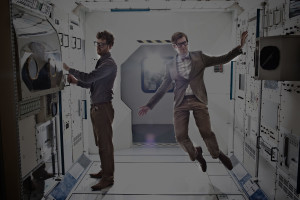 The second track, Sputnik, is a darkly coloured composition that continues to build in energy until it reaches an ominous crescendo. But the central sonic driver of this piece is the constant repeating tone of the Sputnik satellite. Willgoose employs sonic devices and compositional techniques such as these throughout the album as a way that connect the listener with the subject and bring the original experience closer. It’s often a subconscious effect until you realise it’s there.
The second track, Sputnik, is a darkly coloured composition that continues to build in energy until it reaches an ominous crescendo. But the central sonic driver of this piece is the constant repeating tone of the Sputnik satellite. Willgoose employs sonic devices and compositional techniques such as these throughout the album as a way that connect the listener with the subject and bring the original experience closer. It’s often a subconscious effect until you realise it’s there.
Next up is Gagarin, which I’ve previously written about. What I’ve failed to mention about this track is that amidst the funk and frenetic repetition of phrases and Wrigglesworth’s immaculately driven beats is a continued negative tension that builds via a darkly evocative string arrangement full of long bowed whole notes that deliver an effective juxtaposition of sounds as a way of foretelling of Yuri’s death.
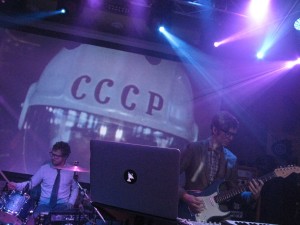 Public Service Broadcasting have previously included tragic thematic content, however on the next track, Fire In The Cockpit, is highly visceral and deeply mournful as it retells the blackest of moments in NASA’s history with the deaths of Apollo 1 astronauts Virgil Grissom, Edward White II, and Roger Chaffee. It’s at this juncture that I forget this is an album by a musicians. Suddenly, the documentary quality of The Race For Space becomes evident, even emotional, and in this state the album transcends its own conceptual nature and becomes something more than music and sounds of space. These historical events are no longer distant reflections, but immediate and engrossing personal experiences.
Public Service Broadcasting have previously included tragic thematic content, however on the next track, Fire In The Cockpit, is highly visceral and deeply mournful as it retells the blackest of moments in NASA’s history with the deaths of Apollo 1 astronauts Virgil Grissom, Edward White II, and Roger Chaffee. It’s at this juncture that I forget this is an album by a musicians. Suddenly, the documentary quality of The Race For Space becomes evident, even emotional, and in this state the album transcends its own conceptual nature and becomes something more than music and sounds of space. These historical events are no longer distant reflections, but immediate and engrossing personal experiences.
This quality continues on E.V.A., which further enhances the poignancy and visceral nature of this album. The urgency of this composition is palpable as the broadcast snippets describe the first E.V.A. (extravehicular activity) walk outside a space capsule. The compositional tension builds with interwoven and repeating guitar and synth phrases until the song reaches a bridge, in which the capsule door opens and the astronaut steps out. The world and the music fall away and we are weightless, floating in space. Only the sounds of lightly pressed piano keys send lonely notes into the emptiness, reverberating into the blackness of space. Willgoose’s compositional effect is breathtaking as it crosses over again into a near documentary form, melding music and story to deliver the essence of the actual experience. As quickly as it starts, the moment is over and we are returned to the song with a renewed orchestral concern and expression. The audio clip announces “ten minutes that shook the world”.
I hope by no means to spoil the experience here for any listeners. This is something that one can’t read about without next listening to the entire album. Continuing in this same documentary form, Side Two, begins with The Other Side, a song that builds on the uneasy anticipation Houston Mission Control’s concern over its immanent loss-of-signal for the Apollo 8 capsule, as it prepares for its first loop around the dark side of the moon. The voice of Houston Control tracks the first loop around the moon in real time: ‘We are go for lunar insertion number one’. As Apollo 8 goes dark, the song fades to quiet and low pulsing synth notes in the background with only the crackle of Houston Control commenting on the passage of time and events.
Slowly as the signal is regained and contact re-established, the instrumentation returns and reaches a triumphant crescendo with buzzing guitars, reverbed synths, thundering drums and cymbal crashes as the capsule emerges from the dark side of the moon. Again the effect is so distinct that we’re able to sense this moment in time as though it were still recent and fresh. The song concludes with cascading vintage synth lines reminiscent of the sounds we used to associate with space.
The following instrumental track, Valentina, is a bit of a breather on the album and features the lovely ethereal vocalisations of the Smoke Fairies. This evocative track, which recalls Valentina Tereshkova, the first woman in space, gently sways with a feminine sweetness even as a military snare snaps a strict rhythm in the background.
From this brief respite, the album and the mission reach their peak. Go! leaps forward to the Apollo 11 Moon landing, crackling with the kinetic energy of sound clips from the landing sequence mixed to a driving composition. On top of the open and airy keyboards sounds and samples, and throbbing bass lines, the drum plays the backbeats. Willgoose then drops in audio clip punctuations on the first and third notes of each measure to form a series call-and-response audio between Mission Control and the Apollo 11 capsule.
The effect is pulsating and dramatic. There are single word queries between Mission Control and astronauts as the landing module prepares its descent. The response is “Go!”. And then finally, “The Eagle has landed”. Swirling layers of staccato guitar phrases relentlessly repeat and build in harmony to merge with the synth and drums — and the final impact is dizzying and quite powerful.
The album concludes with a thought and conversation-provoking piece, Tomorrow. Carrying over the same guitar line from Go!, the mood shifts to an immensely pensive one as it draws on various speeches of astronauts preparing to leave the moon for the last time. As the background choral elements produce both angelic and ominous tones, Gene Cernan gives the final words:
“…As I take man’s last step from the surface, back home for some time to come (but we believe not too long into the future), I’d like to just say what I believe history will record: That America’s challenge of today has forged man’s destiny of tomorrow. And, as we leave the Moon at Taurus-Littrow, we leave as we came and, God willing, as we shall return: with peace and hope for all mankind.”
Then at 4.08, silence.
It’s a remarkable moment lasting a full 69 seconds — a loss of signal perhaps as we float in the deep silence of space looking back at this planet. We’ve come this far, but now war, famine, disease and social strife increasingly threaten our new possibilities for this tomorrow. Only in the silence looking back can we realise just how small, fragile and beautiful is our planet. We’ve achieved so much so quickly and yet have so far to go to discover the unknown. Our continuing existence might depend on it. That’s just the conversation we need to have, and this album is just the type of spark we need to rekindle a new race for space.
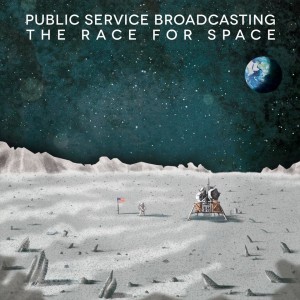 NASA, which granted J Willgoose kind permissions to tap into it’s audio and video archives to produce this work, would do well to ensure the inclusion of this work into their future promotions and documentaries. From end to end, this work is inspired and should be inspiring for future generations. More than a few of these sonic vignettes could easily find a permanent place in the NASA collection.
NASA, which granted J Willgoose kind permissions to tap into it’s audio and video archives to produce this work, would do well to ensure the inclusion of this work into their future promotions and documentaries. From end to end, this work is inspired and should be inspiring for future generations. More than a few of these sonic vignettes could easily find a permanent place in the NASA collection.
As I realise that neither J Willgoose nor Wrigglesworth witnessed the events of this incredible era of science and progress, it makes The Race For Space all the more a singular achievement, one that closely verges on the quality of production one might associate with something from Ken Burns. For Wilgoose’s part, it reflects an attention and dedication to every last detail, and an unwavering focus. He provokes both mental and emotional responses with great élan. Maybe more significant is that this entire orchestration represents the cumulative talents of 33 musicians in addition to J Wilgoose and Wrigglesworth. In all, we hear string quartets, brass sections, choral groups, and more. But it’s my belief that creating this work, J Willgoose and Wrigglesworth have taken part of JFK’s speech to heart. They choose to do these things not because they are easy, but because they are hard. This album is utterly brilliant.
Public Service Broadcasting have just begun their 2015 US tour in Austin at SXSW with a live act that leaves you exhausted and exhilarated. Get out and see this duo by all means.
26 March, Salt Lake City at the Urban Lounge
28 March, Seattle at the Barboza
29 March, Portland at the Doug Fir Lounge
31 March, San Francisco at Above DNA
2 April, Los Angeles at The Roxy Theatre
3 April, Chicago at Schubas
4 April, Toronto at The Drake Hotel
6 April, Ottawa at Algonquin College
7 April , Montreal at the Bar Le Ritz
8 April, Allston at the Great Scott
10 April, New York City at the Bowery Ballroom
11 April, Philadelphia at the World Cafe
For all tour dates and ticket links, go to publicservicebroadcasting.net.
